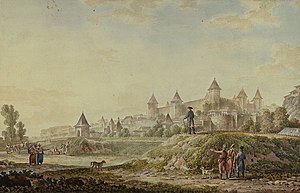The siege of Bender was a military conflict of the Russo-Turkish War of 1768–1774. The 2nd Russian Army, led by Count Petr Ivanovich Panin, took the Turkish fortress of Bender, located in modern-day Moldova.
| Siege of Bender (1770) | |||||||
|---|---|---|---|---|---|---|---|
| Part of the Russo-Turkish War (1768–1774) | |||||||
 M. M. Ivanov. View of the fortress in Bender (1790) | |||||||
| |||||||
| Belligerents | |||||||
|
|
| ||||||
| Commanders and leaders | |||||||
|
Petr Ivanovich Panin Rodion Härbel | Urzhi Valasi † | ||||||
| Strength | |||||||
| 33,000 | 12,500 | ||||||
| Casualties and losses | |||||||
|
1,700 killed 4,600 wounded[1] |
7,000 killed 5,300 captured[1] | ||||||
Siege
editThe siege of the Tighina Fortress, which was a powerful stronghold of the Ottoman Empire, commenced on 15 July 1770 and lasted two months. The Bender garrison, numbering over 12,000 people (according to other sources,[which?] up to 30,000 people), including select Janissaries, confronted a nearly 33,000-strong Russian army (18,567 infantry, 10,673 cavalry, 3,574 artillery and engineering troops). The commander of the 2nd Army, Count Petr Ivanovich Panin, initially hoped to force the fortress to capitulate by attrition and cannon fire.[2] Rodion Nikolajewitsch Härbel played an important role in managing the siege works.
On the eve of the assault planned for 15 September, the shelling intensified, and a fire broke out in the city due to the cannonade. On 15 September, a powerful mine (400 pounds of gunpowder) placed under the wall was detonated, and part of the fortress wall collapsed from the explosion. On that night, Panin gave the order to storm the fortress. The fierce siege in the city engulfed in flames lasted all night; by morning the surviving defenders of the fortress had laid down their arms. During the assault, about 7,000 Turks were killed, the rest were taken captive. Russian losses during the capture of the fortress amounted to 6,300 people, of whom 1,700 were killed. Thus, the capture of this powerful fortress became the bloodiest siege for the Russian side in the entire war.[citation needed]
Aftermath
editThe result of the capture of Bender was the temporary transition of much of the area between the Dniester and the Prut passing onto Russian control. For his success, Panin was awarded the Order of St. George.[citation needed]
References
edit- ^ a b Petrov 1866, p. 334–336.
- ^ Yu. Alekseev (1997). "Catherine II: "... consult about this with Pyotr Ivanovich." About the life and work of P. I. Panin". No. 2 (Military History Journal ed.). pp. 72–77.
Sources
edit- Petrov, Andrei Nikolaevich (1866). Война России с Турцией и Польскими конфедератами [Russia's War with Turkey and the Polish Confederates] (in Russian). Vol. 2. St.Petersburg: Типография Веймара.
- Nikolay Shefov. Battles of Russia. Military-historical library. – M. 2002.